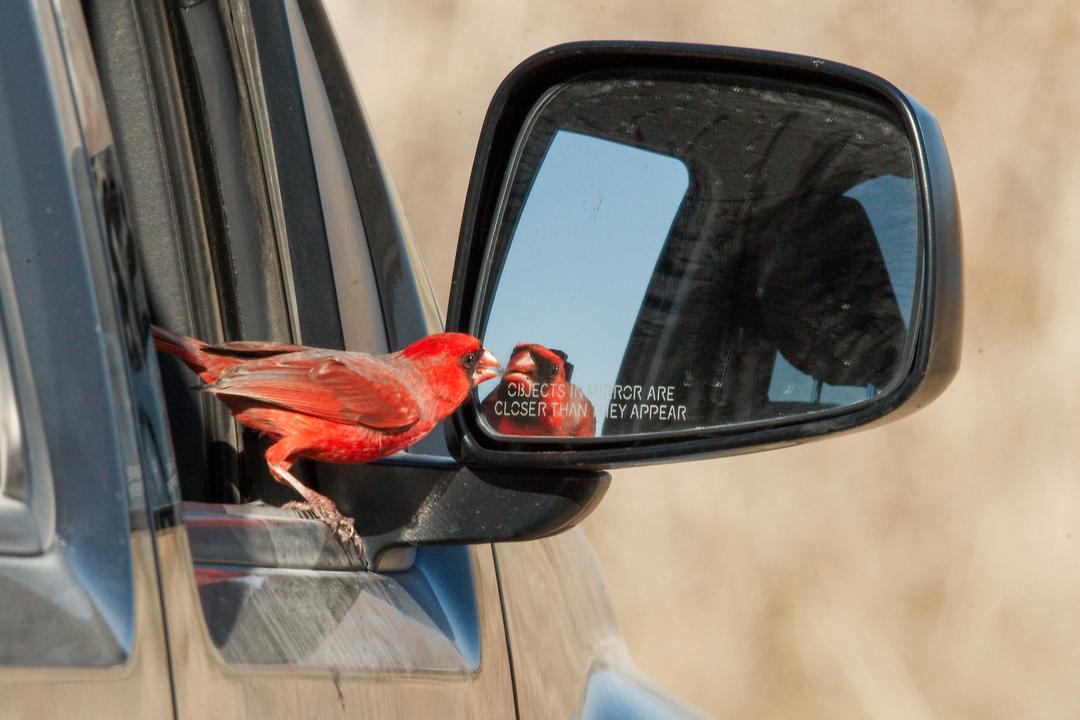Up to a billion birds die in glass collisions each year in the U.S. What's driving the issue with birds and glass, and what can we do about it?
Let’s take a step back and look at basic bird biology. The majority of collision victims are migratory songbirds, and the majority of collisions happen as birds migrate back and forth from their breeding grounds in the spring and fall.
The problem is two-fold. The first is light, which can attract and disorient birds. Our lights will often draw birds into densely-built areas, where they find themselves in close proximity to glass.
Second, the whole point of glass is to be invisible! Glass is made to reflect trees and nature. While people use architectural and visual cues to avoid walking into glass, birds see the world differently: they have a lower contrast sensitivity (they see black and white better than shades of gray) and strong peripheral vision—good for spotting bugs and predators, less helpful for noticing they are about to run into a window.
But bird collisions aren’t just a city problem. Forty four percent of collisions occur at low-rise buildings, including homes. In fact, most collisions occur at the lower levels of buildings, as this is where birds are often foraging and also where trees, plants, and shrubs are often reflected most.
Watch our webinar "The Issue With Birds and Glass" to learn more. Special thanks to our partners at NYC Audubon and Audubon New York
Thanks to the Bird-Window Collision Group (BCWG), a collaboration between The Acopian Center for Ornithology, Muhlenberg College, Lehigh Valley Audubon Society, Wyncote Audubon Society, and Audubon Pennsylvania for many of the photos used in the home collisions portion of this webinar
What are the effects of collisions on birds?
In the United States alone, it is estimated that an average of 100 million to 1 billion birds are killed due to window collisions each year (Loss et al. 2014).
When birds do hit glass, they hit hard, often dying from brain damage (not broken necks). If alive, their injuries often require rehabilitation. Even if a bird is simply stunned, they are at-risk while on the ground, where they could be picked up by predators or stepped on by people or animals.
Organizations like NYC Audubon are dedicated to monitoring the issue of bird collisions and finding solutions. Interested in volunteering? Check out Project Safe Flight: http://www.nycaudubon.org/project-safe-flight.
Why do birds keep attacking my car window? Why is this bird “visiting” our house every day? A bird keeps coming up to our door, does it want to be inside?
We get questions in this vein every spring and summer, right when birds are establishing territories. When birds like cardinals, bluebirds, and finches see another bird that looks like them (even if it’s a reflection), they get pretty upset. While this behavior may not harm the bird, it can tire them out, making them susceptible to exhaustion and predators.
Mitigation is easy! There are many options for breaking up reflections on glass.
Keeping your blinds down or putting objects in windows indoors will only work if the window’s exterior isn’t very shiny and reflective. Your best bet is to break up the reflection on the outside versus inside.
The golden rule of spacing visual indicators on glass is two by four inches apart. Whether you use tempera paint, window decals, or hanging objects of any sort, this spacing makes birds think they can’t fly through.
MORE OPTIONS
Acopian BirdSavers: https://www.birdsavers.com/
Patterend CollidEscape: https://www.collidescape.org/online-store/CollidEscape-High-Performance-Dot-Patterns-p97067235
Feather Friendly bird tape (don’t forget, put it on the OUTSIDE surface!): https://www.featherfriendly.com/
If you do set up bird feeders outside, placing them within three feet of a window will help decrease risk of collisions.
What else can we do about bird collisions? How is science driving change?
The more we know about the extent of the bird collision problem, the more we can educate architects, lawmakers, building owners, and more.
An online crowd-sourcing data collection tool by NYC Audubon, D-Bird provides a way for the public to enter records of dead or injured birds. Contributors come from all over the world, and this crowd-sourced data helps scientists study the scope of the issue and find solutions. If you find a dead or injured bird, you can click here to submit a report through D-Bird.
We're also taking advocacy action to turn science into law.
IN PROCESS! [As of July 2020] HR919, the “Bird Safe Buildings Act,” requires public buildings constructed, acquired, or of which more than fifty percent of the façade is substantially altered by the General Services Administration, use bird-friendly materials. You can contact your US Senator about this bill here: https://act.audubon.org/onlineactions/cFKDdto0hEC6HqnxgB0y-Q2
If you are in need of a wildlife rehabilitator, check out these resources, and thank you for helping save a bird's life.
A list of CT DEEP-approved animal rehabilitators: https://portal.ct.gov/DEEP/Wildlife/Rehabilitator/Animals-in-Distress/Small-Birds-in-Distress
Animal Help Now: https://ahnow.org/
Sharon Audubon Center's resource and information page on how to help birds that appear injured or orphaned: https://sharon.audubon.org/wildlife-tips
How you can help, right now
Get Involved
There are so many great ways you can get involved with Audubon Connecticut and make a difference for both the wildlife and the people who call Connecticut home.
Visit Our Centers
Connect with our nature centers in Greenwich, Sharon, and Southbury. Each unique center offers trails, educational resources, conservation opportunities, and more.
Support Us
Through land stewardship, science, education, and advocacy, Audubon Connecticut works across the state to preserve habitat and protect bird species that are of state, national, and global concern.






